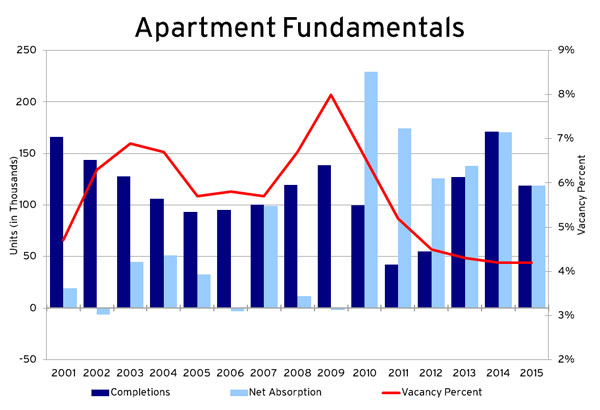Much has been written recently about potential risks to overbuilding in multifamily—in fact, I commented on this issue last April in my NREI column, but I noted that analyzing the supply side is not enough. Demand for apartments will remain strong, and will rise further if economic growth quickens.
Apartment fundamentals have bounced back robustly since the recession ended in June 2009. Despite middling economic growth, the national vacancy rate dropped sharply from a peak of 8.0 percent at the end of 2009 to 4.6 percent in the third quarter of 2012. Vacancy rates that are this low have not been observed since late 2001.
Asking and effective rents have risen for 11 consecutive quarters and in many areas have surpassed previous peaks achieved in the third quarter of 2008, before the fall of Lehman Brothers. Landlords face little pressure to offer concessions given how tight rental markets are in most places.
Construction also remains tight, with less than 37,000 units coming online over the last three quarters of 2012. An additional 18,000 units are expected to open their doors in the fourth quarter; that adds up to about 55,000 units for the year, a slight increase from 2011 but well below the 125,000 annual average from 2000 to 2009.
Gradual return to normalcy
Earlier in 2012, there were signs that construction would spike in 2013, in the order of 150,000 to 200,000 units. Developers have since postponed many projects to 2014, so that 2013 figures hover closer to 130,000 units—not far off from the pre-recession 10-year average. The “bubble” now shows up in 2014, but if economic growth ramps up by then (Moody’s Economy.com is projecting GDP growth of over 4 percent in 2014, up significantly from 2.0 percent in 2012 and 2.9 percent in 2013), the additional supply will most likely be absorbed relatively painlessly.

This is not to say that certain metros will not be at risk. Washington, D.C. and suburban Maryland, for instance, both face historically high inventory growth prospects over the next couple of years; these metros cannot rely on solid demand drivers like strong employment growth in certain sectors such as tech to push demand for rentals like Austin, Texas or Seattle.
While the single-family housing market finally appears to be on the mend, this does not automatically mean less demand for multifamily. Jay Lybik, vice president for market research at Equity Residential, a Chicago-based REIT, tracks move-outs very closely every quarter and has witnessed little to no change in the number of residents leaving to buy a home. Data from the National Association of Realtors also shows first-time home-buyers percentage of sales flat after spiking due to the Home Buyer Tax Credit, which expired in 2010. Single-family homes that are being purchased by investors for rent cater to different household types than investment-grade multifamily properties. Single-family rentals see households with children as their largest household type compared to investment-grade multifamily properties in which singles dominate, especially in urban locations.
The near future
Apartment fundamentals do not face a cliff, given the rise in new completions. Construction activity has been so depressed over the last two years that even new units coming on line only represent a return to recent average inventory growth rates.
However, that does not mean that apartment vacancies will continue to crater more than 100 basis points per year, since current levels are already so tight. Reis projects vacancies to remain in the low 4 percentages through 2015, not much lower than its current 4.6 percent. Landlords recognize this, and have shifted their focus from improving occupancy to raising rents to meet revenue goals.
There is a limit to how much landlords can raise rents as well, given that household income levels have remained relatively stagnant. But if GDP growth improves and the economic pie starts growing at a faster rate, apartment properties are poised to share in the benefits as well.
As such, apartment investors are likely to do well in the foreseeable future. Certain transactions with going-in cap rates below 3 percent will encounter significant exit challenges if and when interest rates rise, but market participants with realistic expectations will find it difficult to pick a sector with prospects as sound as multifamily.
For more related topics, visit Real Estate Investment 101.
Related Posts
- Home Values Dropping In 27 Of 50 U.S. States As The Housing Market Shifts Amid Continuing High Interest Rates, Zillow Data Shows
- Falling home prices are raising the risk of a deeper correction as the housing market cracks under high mortgage rates
- Here’s the latest sign that the US housing market has frozen over
- Lower prices boost new US home sales; outlook downbeat amid higher mortgages
- US existing home sales unexpectedly fall in April
Tags: Real Estate Investment